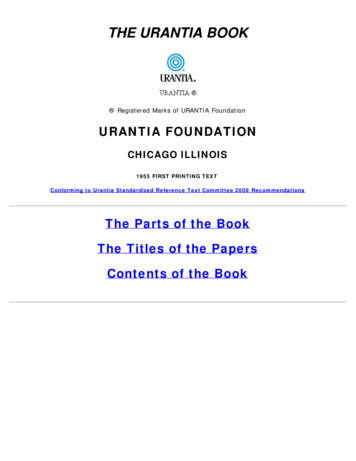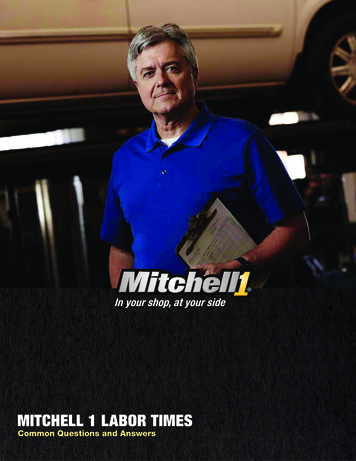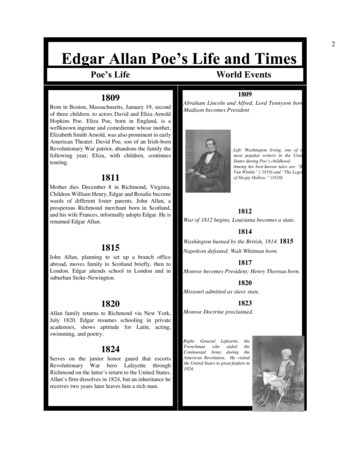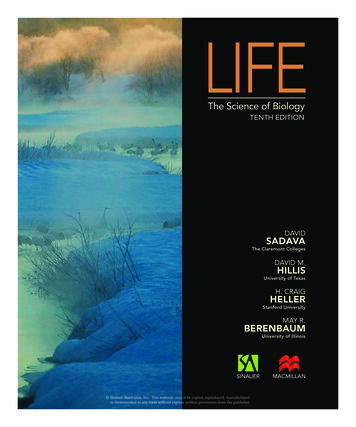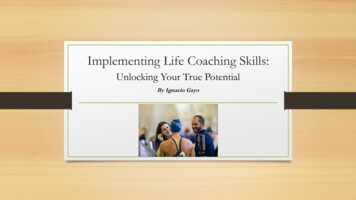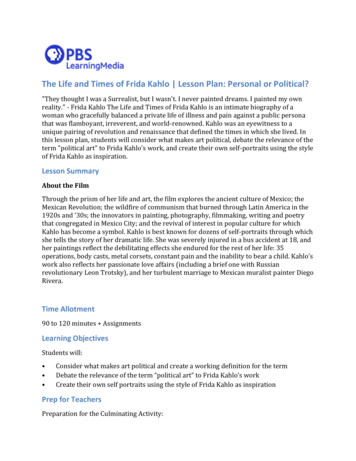
Transcription
The Life and Times of Frida Kahlo Lesson Plan: Personal or Political?"They thought I was a Surrealist, but I wasn't. I never painted dreams. I painted my ownreality." - Frida Kahlo The Life and Times of Frida Kahlo is an intimate biography of awoman who gracefully balanced a private life of illness and pain against a public personathat was flamboyant, irreverent, and world-renowned. Kahlo was an eyewitness to aunique pairing of revolution and renaissance that defined the times in which she lived. Inthis lesson plan, students will consider what makes art political, debate the relevance of theterm "political art" to Frida Kahlo’s work, and create their own self-portraits using the styleof Frida Kahlo as inspiration.Lesson SummaryAbout the FilmThrough the prism of her life and art, the film explores the ancient culture of Mexico; theMexican Revolution; the wildfire of communism that burned through Latin America in the1920s and '30s; the innovators in painting, photography, filmmaking, writing and poetrythat congregated in Mexico City; and the revival of interest in popular culture for whichKahlo has become a symbol. Kahlo is best known for dozens of self-portraits through whichshe tells the story of her dramatic life. She was severely injured in a bus accident at 18, andher paintings reflect the debilitating effects she endured for the rest of her life: 35operations, body casts, metal corsets, constant pain and the inability to bear a child. Kahlo'swork also reflects her passionate love affairs (including a brief one with Russianrevolutionary Leon Trotsky), and her turbulent marriage to Mexican muralist painter DiegoRivera.Time Allotment90 to 120 minutes AssignmentsLearning ObjectivesStudents will: Consider what makes art political and create a working definition for the termDebate the relevance of the term “political art” to Frida Kahlo’s workCreate their own self portraits using the style of Frida Kahlo as inspirationPrep for TeachersPreparation for the Culminating Activity:
In advance of the lesson, ask students to submit a digital file of a photograph of themselves.Print the student photos for the collages as follows: use standard full 8.5 x 11 copy paper,print the images full size (one image per page), print in black and white, not color. Note: theprints do not need to be “photo quality” since they will be used as the basis for the collageand will be drawn on, cut, and manipulated.Supplies Film Module: Frida Kahlo Personal or Political?Computers with Internet accessLCD projectorSpeakersWhiteboard or blackboardPen and writing paperArt suppliesSTUDENT HANDOUT A: PORTRAYAL, PROMOTION, AND PROJECTIONSTUDENT HANDOUT B: SELF-PORTRAIT BRAINSTORMINGTEACHER HANDOUT A: PORTRAYAL, PROMOTION, AND PROJECTION ARTWORKHANDOUT: ABOUT THE FILMIntroductory ActivityDO NOW: THINK-PAIR-SHARETime: 10 minutesSupplies: Whiteboard/blackboard, markers/chalk, pens/pencils, writing paperSummary: Students will engage in a guided discussion and debate about what makes art“political” Think-Pair-Share: Write the term “Political Art” on the board and give students twominutes to list three essential characteristics that make a piece of art political. Havethe students pair-up, discuss their responses, and create a definition for “Political Art”.Ask pairs to share their responses and record the results on the board. Compare andcontrast the definitions the students came up and ask volunteers to give feedback.Begin to refine the student responses into a single rough definition to be revisited andrevised throughout the class period.Learning ActivitiesACTIVITY 1: WHAT IS “POLITICAL ART”?Time: 30 minutesSupplies: Whiteboard/blackboard, markers/chalk, pens/pencils, writing paper Handouts:STUDENT HANDOUT A: PORTRAYAL, PROMOTION, AND PROJECTION, TEACHERHANDOUT A: PORTRAYAL, PROMOTION, AND PROJECTION ARTWORK.
Summary: Students will engage in a guided discussion and debate about what makes art“political”. They will be introduced to a selection of existing definitions or descriptions forthe term and three ways of framing political art as Portrayal, Promotion, or Projection.Using this discussion as a jumping-off point, the class will create a working definition forthe term “political art”, which they will revisit and refine throughout the lesson. They willthen view a selection of artwork that will include work by Frida Kahlo and will discusswhich of these works are political and why, based on the definition they have developed.Explain that, although Political Art is a common term there is no universal definition forwhat that means. Share the following examples of definitions for “Political Art”, discusseach, then revisit the class definition and ask for feedback on how it can be revised and/orimproved: 1.2.3.4.5.6.“In the visual arts, work that contains political subject matter, takes a stand on anissue, addresses a public concern, or awakens viewer sensitivity. “ Encyclo.co.uk“Artists often deploy their work strategically to engage viewers in critical inquiry ofsocial, economic, and political issues that define a particular moment. Artconsistently toys with notions of power, whether to comment on the horrors of war, or to pay homage to powerful figures, as reflected in more traditional forms such asmonuments, presidential portraits, and religious imagery. On the other hand, art canalso serve the controversial function of propaganda” - Mark Mayer, Art and Politics: AnIntroduction, Art:21 Blog, January 2009“Every artwork is political in the sense that it offers a perspective—direct orindirect—on social relations. Andy Warhol’s images of Campbell’s Soup cans, forinstance, celebrate consumer culture rather than criticize it. Jackson Pollock’sabstractions proclaim the role of the artist as a free agent unencumbered by thedemands of creating recognizable images. The politics are almost invariably easier tospot in premodern works, such as portraits of kings or popes that frankly announcethemselves as emblems of social power.” – The Museum of Contemporary Art, LosAngeles (MoCA)Discussion Questions:How does the class definition compare to these explanations for Political Art?What do you think MoCA means when it says that “every artwork is political”? Do youagree or disagree and why?Divide the class into groups of 3 to 5 students and provide each with STUDENTHANDOUT A: PORTRAYAL, PROMOTION, AND PROJECTION.Ask the group to take five minutes to review and discuss the definitions on Page 1.Using the suggested artwork in TEACHER HANDOUT A: PORTRAYAL, PROMOTION,AND PROJECTION ARTWORK, ask groups to consider if and why each images ispolitical art. Once the class has looked at all of the artwork, discuss their responses.Revisit the working definition for “Political Art” and ask if the class would like to makeany further refinements based on this activity.ACTIVITY 2: SCREENING THE FILM MODULE
Time: 20 minutesSupplies: pens and writing paper, LCD projector and/or DVD playerFilm Module: Frida Kahlo: Personal or Political? (15:38 minutes)Handouts: ABOUT THE FILM Provide students with ABOUT THE FILM handout and discuss briefly as a class. Thishandout can also be given as homework for students to read in advance of the lesson.Building on the group discussion from the prescreening activity, instruct the studentsto take notes while watching the video and ask them to note quotes, events, andterms that relate to the ongoing discussion of Political Art.POST SCREENING DISCUSSION: 1.2.3. 1.2.3.4.5.6.7.8.Ask for volunteers to share their notes from the screening and discussShare the following three quotes from the film and give students two minutes to rewrite one quote in their own words. Ask for volunteers to share their rewording of thequote and discuss the significance and what it means to them. (Students can choose aquote or the quote can be assigned. Students can also work with a partner to translatethe quote into their own language.)“Frida transformed her life by painting herself”“Frida improvised her own kind of freedom.”She made “her own life into a work of art.Further discuss the film using the following prompts:What surprised you most when watching the film? Were you aware of Frida Kahlobefore, and if so, did your understanding of her life and work change after viewing thisdocumentary?If asked what type of person Frida Kahlo was, how would you describe her?Identify the ways Frida demonstrated her individuality (i.e., dress, artistic style,lifestyle, peers). Determine why Frida chose to present herself in these fashions (i.e.,political and social statements, rebelliousness, artistic license, and personal andaesthetic style).Frida came of age following the Revolution during a period of time when “the nationwas finding out what it looked like.” How did the changing attitude toward nationalhistory and national mythology affect Frida and her work?How did Frida's painting style change over time? For example, when did she primarilybegin to paint self-portraits? What did they typically depict?Why did Frida choose herself as the principal subject of her art? What does this choicesuggest about Frida, in terms of her character, outlook on life and personalexperiences?Why is her attitude toward her disability seen as so radical?What impact, if any, did Frida’s political ideals have on her artwork? What political,religious, cultural and social references are embedded in her paintings? How was her
expression of her political beliefs in her artwork compare to other artists of the erasuch as Diego Rivera?9. In your opinion, what largely drew attention to Frida - her artwork or lifestyle orrelationships? She is now a recognized and valued artist, but during her lifetime,Frida's paintings did not get much attention. To what do you attribute this laterecognition and current popularity of her artwork?10. Do you think Frida is a political artist? Why or why not?ACTIVITY 3: PERSONAL OR POLITICAL?Time: 40-60 minutesSupplies: Whiteboard/blackboard, markers/chalk, pens/pencils, writing paperSummary: Students will consider Frida Kahlo’s work in the context of the class’ workingdefinition of “Political Art”. They will be introduced to the political argument the personalis political” which came to prominence through the feminist movement of the 1960s anddiscuss the relevance of this idea to Kahlo’s work. They will work in groups to examinepaintings by Frida Kahlo and to develop arguments for and against identifying the imagesas political art. 1.2. 1.2.Write “the personal is political” on the board and ask students to take one minute tore-write the phrase in their own words in a way that describes what it means to them.Ask for volunteers to share and give feedback.Explain that the “the personal is political” is a political argument that came toprominence through the women’s movement of the 1960s and states thatconsciousness-raising (the activity of seeking to make people more aware social,political, and personal issues) is a form of political action because it raises discussionabout topics that are not always seen as political such as women's roles inrelationships and marriage, body-image, and feelings about childbearing and childrearing. This idea was popularized by the women’s movement, but was intended toextend beyond gender to understandings of race, class, economics, etc. Discuss usingthe following prompts:Do you agree with the argument that “the personal is political”? Why or why not?Can you give an example to support or disprove this concept?Divide the class into groups of 3-5 students (mix-up the groups from Activity 1, ifpossible) and assign each group one of Frida Kahlo’s paintings to examine. Images canbe found at the following websites:PROA Fundacion: Frida Kahlo Works - View fourteen of Frida's most famous works.Titles and captions are in Spanish.Frida Kahlo and Contemporary Thoughts - An extensive site dedicated to Frida whereyou will find links to paintings, critical essays and a bibliography. Also has aninteresting flash movie using images and quotes from Frida. http://www.fridakahlo.it/
1.2.3.4.Each group will need to use the working definition of Political Art and the responsesfrom the class discussion to develop an argument for and against identifying theirimage as an example of political art.Have each group present their results to the class and engage in a guided discussionabout what they discovered using the following prompts:Is Frida Kahlo a political artist? Why or why not?Does it matter if her art is political or personal? Can it be both?How has your understanding or expectation of Political Art changed since thebeginning of this lesson?Do we need to revise our definition of “political art” based on what we haveexperienced and observed through this lesson?Culminating ActivityTHE LIFE AND TIMES OF YOUTime: 30 minutes AssignmentsSupplies: Student photos, old magazines, drawing paper, art supplies (markers, scissors,glue sticks, color pencils, etc.), computers and photo editing software (optional)Handouts: STUDENT HANDOUT B: SELF-PORTRAIT BRAINSTORMINGPreparation: In advance of the lesson, ask students to submit a digital file of a photographof themselves. Print the student photos for the collages as follows: use standard full 8.5 x11 copy paper, print the images full size (one image per page), print in black and white, notcolor. Note: the prints do not need to be “photo quality” since they will be used as the basisfor the collage and will be drawn on, cut, and manipulated.Summary: Students will be guided through the creation of their own self-portrait collageusing Frida Kahlo’s work as inspiration. Review and explain: Frida Kahlo used self-portraiture and symbols to express herthoughts, emotions, values, and experiences and to convey her personal identitywithin the cultural and political climate in which she lived. We will use Frida Kahlo’swork as the inspiration to create our own self-portraits.Distribute STUDENT HANDOUT B: SELF-PORTRAIT BRAINSTORMING or ask studentsto draw a large circle on a blank sheet of paper.Tell students that they will have 1 minute to think and write down of all the externalinfluences that have shaped who they are and how they understand their world (forexample: cultural traditions, family, the place they live, music, world and local events,social issues, movies, etc.). They should write their responses on the outside of thecircle. Ask students to be specific (if movies have influenced them list the name of aspecific movie or movies). When time is up ask them to share their responses with apartner and ask for volunteers to share with the class.Repeat the process but have the students write words or phrases that describethemselves inside the circle. Be specific and ask them to steer clear of superficial
descriptions such as “cute” or “tall”. Their responses can include descriptions of howthey see themselves as well as how they think other people see them. When theyfinish, ask them to share their responses with a partner and ask for volunteers to sharewith the class.Explain: Your responses to this activity will guide the creation of your self-portraitcollage. Think about the external influences that have shaped who you are and thewords you used to describe yourself. What images, symbols, colors, or objects can youuse to illustrate these ideas?Student collages should start with a photograph or self-portrait drawing that can bedeveloped through the addition of drawings or magazine cutouts. If computers andsoftware are available, students could create digital collages using sample images,GIFs, and digital drawing.Once students have completed their collages, ask them to swap with a partner andrepeat the process from Activity 2.Writing Assignment: Have students write an artist statement that describes theprocess and meaning behind their individual work as well as its relationship to theirunderstanding of Political Art.Complete the project by exhibiting the student’s work and artist statements in theclassroom or communal areas of the school. Student work can also be displayed andcelebrated on a class webpage or school blog.EXTENSION ACTIVITIESA Likely and Unlikely Match: Frida and DiegoAdapted from The Life and Times of Frida Kahlo website Educational GuideHave students explore the relationship between Frida Kahlo and Diego Rivera and explorehow each incorporates their relationship and their politics into their work. Students canfurther explore the contrast in Frida and Diego’s expression of their life experiences bymaking a second self-portrait in the style of Diego Rivera. Visit the website for additionaldiscussion questions and es/teachers match.htmlThe Real and Surreal in Frida’s Life and ArtAlthough Frida Kahlo’s work has been described as surrealism, she once wrote that shenever knew she was a surrealist "until André Breton came to Mexico and told me I wasone." However, Frida eschewed labels while Diego argued that Frida was a realist. Havestudents research the surrealist movement and manifesto and compare and contrast theaesthetic and ideals of this movement with Frida’s work. What cultural and social changesinfluenced the development of the surrealist philosophy? Was surrealism a “new idea” oran adaptation of existing aesthetics and traditions? What influence, if any, does Frida’s
cultural heritage have on her expression of her reality? Does the label “surrealism” apply toFrida?The Influence of BattleAdapted from The Life and Times of Frida Kahlo website Educational GuideThe Mexican Revolution played a key role in Frida's life and art. She lived through it andexperienced many aspects of the war firsthand. In fact, she and her mother tended thewounded in their home. Discuss what impact the revolution had on Frida, her family, andon Mexico. Compare/contrast Frida’s expression of this revolutionary period withexamples of political art by her contemporaries (Rivera, Orozco, Siqueiros) and discuss thesimilarities and differences in their style and goals. Visit the website for additionaldiscussion questions and es/parents act2.htmlADDITIONAL RESOURCESWebsites PROA Fundacion: Frida Kahlo Works - View fourteen of Frida's most famous works.Titles and captions are in Spanish. tmlFrida by Kahlo - View Frida's work in the context of her life.http://www.fbuch.com/fridaby.htmFrida Kahlo: Self Portraits - This site focuses on the self portraits.http://www.mexconnect.com/mex /travel/jcummings/ph56frida.htmlFrida Kahlo and Contemporary Thoughts - An extensive site dedicated to Frida whereyou will find links to paintings, critical essays and a bibliography. Also has aninteresting flash movie using images and quotes from Frida. http://www.fridakahlo.it/National Museum of Women in the Arts - Artist profile of Frida as well as a descriptionof "Self-Portrait Dedicated to Leon Trotsky" can be found at this nkID 471Books Herrera, Hayden. Frida: A Biography of Frida Kahlo. New York: HarperCollinsPublishers, 2002.Herrera, Hayden. Frida Kahlo: The Paintings. New York: HarperCollins, 1993.Kettenmann Adrea. Kahlo. Köln, Germany: Taschen, 2000.
Udall, Sharyn Rohlfsen. Carr, O'Keefe, Kahlo: Places of Their Own. New Haven andLondon: Yale University Press, 2000.Reprinted from PBS LearningMedia: The Life and Times of Frida Kahlo Lesson Plan:Personal or n/ 2016-12-11 19:00:00 Latino Public Broadcasting. All Rights Reserved. For personal orclassroom use only. Not for redistribution.
reality." - Frida Kahlo The Life and Times of Frida Kahlo is an intimate biography of a woman who gracefully balanced a private life of illness and pain against a public persona that was flamboyant, irreverent, and world-renowned. Kahlo was an eyewitness to a unique pairing of revolution and


